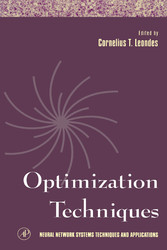Search and Find
Service
Front Cover
1
Optimization Techniques
4
Copyright Page
5
Contents
6
Contributors
16
Preface
18
Chapter 1. Optimal Learning in Artificial Neural Networks: A Theoretical View
24
I. Introduction
24
II. Formulation of Learning as an Optimization Problem
27
III. Learning with No Local Minima
33
IV. Learning with Suboptimal Solutions
56
V. Advanced Techniques for Optimal Learning
67
VI. Conclusions
68
References
70
Chapter 2. Orthogonal Transformation Techniques in the Optimization of Feedforward Neural Network Systems
76
I. Introduction
76
II. Mathematical Background for the Transformations Used
78
III. Network-Size Optimization through Subset Selection
81
IV. Introduction to Illustrative Examples
84
V. Example 1: Modeling of the Mackey–Glass Series
85
VI. Example 2: Modeling of the Sunspot Series
88
VII. Example 3: Modeling of the Rocket Engine Testing Problem
94
VIII. Assessment of Convergence in Training Using Singular Value Decomposition
97
IX. Conclusions
99
Appendix A: Configuration of a Series with Nearly Repeating Periodicity for Singular Value Decomposition-Based Analysis
99
Appendix B: Singular Value Ratio Spectrum
100
References
100
Chapter 3. Sequential Constructive Techniques
104
I. Introduction
104
II. Problems in Training with Back Propagation
105
III. Constructive Training Methods
108
IV. Sequential Constructive Methods: General Structure
111
V. Sequential Constructive Methods: Specific Approaches
128
VI. Hamming Clustering Procedure
146
VII. Experimental Results
148
VIII. Conclusions
162
References
163
Chapter 4. Fast Backpropagation Training Using Optimal Learning Rate and Momentum
168
I. Introduction
168
II. Computation of Derivatives of Learning Parameters
171
III. Optimization of Dynamic Learning Rate
177
IV. Simultaneous Optimization of µ and a
181
V. Selection of the Descent Direction
183
VI. Simulation Results
184
VII. Conclusion
191
References
195
Chapter 5. Learning of Nonstationary Processes
198
I. Introduction
198
II. A Priori Limitations
200
III. Formalization of the Problem
201
IV. Transformation into an Unconstrained Minimization Problem
202
V. One-to-One Mapping D
205
VI. Learning with Minimal Degradation Algorithm
206
VII. Adaptation of Learning with Minimal Degradation for Radial Basis Function Units
209
VIII. Choosing the Coefficients of the Cost Function
211
IX. Implementation Details
213
X. Performance Measures
214
XI. Experimental Results
217
XII. Discussion
223
XIII. Conclusion
227
References
229
Chapter 6. Constraint Satisfaction Problems
232
I. Constraint Satisfaction Problems
232
II. Assessment Criteria for Constraint Satisfaction Techniques
236
III. Constraint Satisfaction Techniques
244
IV. Neural Networks for Constraint Satisfaction
250
V. Assessment
263
References
267
Chapter 7. Dominant Neuron Techniques
272
I. Introduction
272
II. Continuous Winner-Take-All Neural Networks
275
III. Iterative Winner-Take-All Neural Networks
279
IV. K-Winners-Take-All Neural Networks
291
V. Conclusions
296
References
297
Chapter 8. CMAC-Based Techniques for Adaptive Learning Control
300
I. Introduction
300
II. Neural Networks for Learning Control
301
III. Conventional Cerebellar Model Articulation Controller
307
IV. Advanced Cerebellar Model Articulation Controller-Based Techniques
313
V. Structure Composed of Small Cerebellar Model Articulation Controllers
321
VI. Conclusions
325
References
326
Chapter 9. Information Dynamics and Neural Techniques for Data Analysis
328
I. Introduction
328
II. Statistical Structure Extraction: Parametric Formulation by Unsupervised Neural Learning
330
III. Statistical Structure Extraction: Nonparametric Formulation
349
IV. Nonparametric Characterization of Dynamics: The Information Flow Concept
360
V. Conclusions
368
References
372
Chapter 10. Radial Basis Function Network Approximation and Learning in Task-Dependent Feedforward Control of Nonlinear Dynamical Systems
376
I. Introduction
376
II. Problem Statement
380
III. Radial Basis Function Approximation
389
IV. Learning Feedforward for a Given Task
396
V. On-Line Learning Update in Task-Dependent Feedforward
401
VI. Adaptive Learning of Task-Dependent Feedforward
405
VII. Conclusions
414
References
414
Index
418
Erratum
422
All prices incl. VAT











